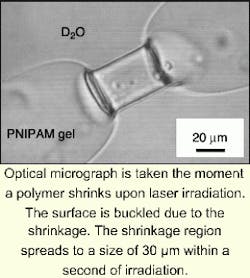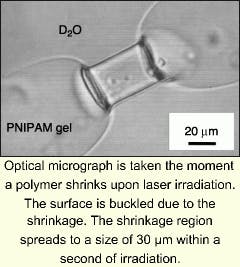Laser light transforms polymer gel
Incorporating news from O plus E magazine, Tokyo
TOKUSHIMAThe volume of a polymer is determined by the balance between interactions such as electrostatics, hydrophobicity, hydrogen bonds, and van del Waals interactions. In general, this balance can be changed by adjusting pH, temperature, the composition of the solute, and the composition of the gel. Now, researchers at Tokushima University Graduate School of Engineering have transformed a polymer gel by laser irradiation.
The gel used is a stick-type material called poly-N-isopropyl-acryl-amide (PNIPAM); a condensed Gaussian beam from a 1064-nm-emitting Nd:YAG laser irradiates the gel. The solute of choice is heavy water (D2O), which does not heat up when the laser beam is applied. When the light is turned off, the gel returns to normal.
The gel shrinks because of the momentum conservation of light. The radiation pressure of the laser light is transferred to the gel. Radiation pressure can be expressed as the change in momentum of one photon multiplied by the number of photons ejected per unit time. A Gaussian beam has the highest photon flux at its axis, with the flux decreasing toward the outer edges. Consequently, the radiation pressure has its force directed toward the focus of the beama force that causes the gel to shrink. The radius of the laser beam is 1.5 µm; the gel shrinks within the region where the radiation pressure goes above 25 MPa. Computer simulations show that the surrounding region is dragged in as well, increasing the shrinkage region up to 30 µm. This is the first time that a polymer gel has been transformed by manipulating molecular-level interactions via laser irradiation.
Courtesy O plus E magazine, Tokyo

